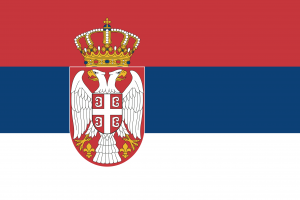Language/Serbian/Culture/Medieval-Serbian-Literature
 Հայերէն
Հայերէն Български език
Български език 官话
官话 官話
官話 Hrvatski jezik
Hrvatski jezik Český jazyk
Český jazyk Nederlands
Nederlands English
English Suomen kieli
Suomen kieli Français
Français Deutsch
Deutsch עברית
עברית हिन्दी
हिन्दी Magyar
Magyar Bahasa Indonesia
Bahasa Indonesia فارسی
فارسی Italiano
Italiano 日本語
日本語 Қазақ тілі
Қазақ тілі 한국어
한국어 Lietuvių kalba
Lietuvių kalba Νέα Ελληνικά
Νέα Ελληνικά Şimali Azərbaycanlılar
Şimali Azərbaycanlılar Język polski
Język polski Português
Português Limba Română
Limba Română Русский язык
Русский язык Español
Español العربية القياسية
العربية القياسية Svenska
Svenska Wikang Tagalog
Wikang Tagalog தமிழ்
தமிழ் ภาษาไทย
ภาษาไทย Türkçe
Türkçe Українська мова
Українська мова Urdu
Urdu Tiếng Việt
Tiếng Việt
| ◀️ Education and Learning — Previous Lesson | Next Lesson — Contemporary Serbian Poetry ▶️ |
Overview
Medieval Serbian literature is a rich and diverse cultural heritage, which reflects the complex historical and social context of Serbia, from the 12th to the 16th century. Serbia was at the crossroads of many different cultures (Byzantine, Ottoman, Western), which resulted in a unique synthesis of artistic and literary expressions.
The medieval Serbian literature includes epic poems, religious texts, historical chronicles, biographies of saints, and folk songs. This literature was written in Old Church Slavonic, which was the official liturgical language of the Eastern Orthodox Church, but also in Serbian, a vernacular language that gradually gained more prestige and recognition.
Major Works of Medieval Serbian Literature
Epic Poetry: Kosovo Cycle
The epic poetry of medieval Serbia is primarily focused on the heroic history and legends of the Serbian people. The most significant epic poems belong to the Kosovo cycle, a group of interrelated narratives that revolve around the battle of Kosovo (1389), where the Serbian forces were defeated by the Ottoman Turks. The Kosovo cycle includes:
- The Song of Prince Marko (Marko Kraljevic): The most famous of all Serbian epic poems, sung and recited throughout the Balkans. It tells the story of Prince Marko, a legendary hero who fought against the Turks and other enemies of the Serbian people. The poem combines elements of history, mythology, and Christian beliefs.
- The Death of the Mother of the Jugović Family: A tragic story of a mother who loses all her sons in the battle of Kosovo, but remains loyal to her faith and homeland until the end. The poem praises the sacrifice and courage of the Serbian people against the overwhelming odds.
- The Banovic Strahinja: A romance between a Serbian knight and a Turkish princess, which dramatizes the conflict between love and duty, loyalty and honor, faith and politics. The poem is famous for its vivid descriptions of the medieval courtship and chivalry.
- The Prince's Mistress: A story of a nobleman who falls in love with a beautiful gypsy girl, but has to face the hatred and jealousy of his peers and rivals. The poem reflects the tension between the aristocratic and the popular culture in medieval Serbia.
- The Sword of Kraljevic Marko: A supernatural story of a magic sword that brings good luck and fortune to its owner, but also curses and betrayal to those who steal it. The poem illustrates the importance of honor and generosity in the Serbian epic tradition.
Religious Texts: Hagiography and Sermons
Medieval Serbian literature also includes many texts related to Orthodox Christianity, which was the dominant religion in Serbia. The most important religious texts are:
- The Miroslav Gospel: One of the oldest and most valuable manuscripts of the Serbian Orthodox Church, written in the 12th century by Miroslav, a Serbian prince and hagiographer. The Gospel contains the four Gospels in Old Church Slavonic, adorned with intricate illuminations and decorations.
- The Saint Sava's Nomocanon: A collection of canon law regulations and ecclesiastical rules, compiled by Saint Sava, the founder of the Serbian Orthodox Church and the first archbishop of Serbia. The Nomocanon reflects the complex relationship between the church and the state, and the role of religion in the medieval Serbian society.
- The Sermons of Saint Isaiah the Solitary: A series of moral and ethical teachings, delivered by Saint Isaiah the Solitary, a Byzantine monk who lived in the 4th century. The sermons deal with the issues of temptation, sin, repentance, prayer, and the nature of God.
Chronicles and Histories: Domentian and Nestor
Medieval Serbian literature also produced several chronicles and histories, which recorded the political and cultural events of the Serbian state. The most notable chroniclers are:
- Domentian: A monk who wrote the chronicle of the Serbian archbishops, from the 12th to the 14th century. The chronicle includes the biographies of the archbishops, the history of the church, and the major political and social upheavals of the time.
- Nestor the Chronicler: A Serbian historian who wrote the Slavic-Serbian Chronicle in the 15th century. The chronicle covers the period from the arrival of the Slavs to the Balkans to the end of the 14th century, including the mythical origins of the Slavic people, the formation of the Serbian state, the wars against the Ottomans, and the cultural and religious achievements of the Serbs.
Conclusion
Medieval Serbian literature is a fascinating and complex artistic expression, which deserves to be widely known and appreciated. The epic poetry, religious texts, and historical chronicles of Serbia provide a unique insight into the cultural and social identity of the Serbian people, and their enduring legacy in the Balkans and beyond.
Sources
- <a href="https://en.wikipedia.org/wiki/Serbian_literature">Serbian literature</a>
- <a href="https://en.wikipedia.org/wiki/Medieval_Serbian_literature">Medieval Serbian literature</a>
Impressive work on finishing this lesson! Explore these additional pages to enhance your understanding: Contemporary Serbian Poetry & Kosovo Timeline.
Other Lessons
- Traditional Serbian Music
- Music Festivals
- Serbia Timeline
- Serbian Films
- Cuisine
- Football in Serbia
- Winter Sports
- Montenegro Timeline
- Kosovo Timeline
Sources
- Medieval Serbian literature - Wikipedia
- Serbian Culture - Serbia.com
- Medieval Serbian Culture: Peic, Sava: 9780881682632: Amazon ...
| ◀️ Education and Learning — Previous Lesson | Next Lesson — Contemporary Serbian Poetry ▶️ |

